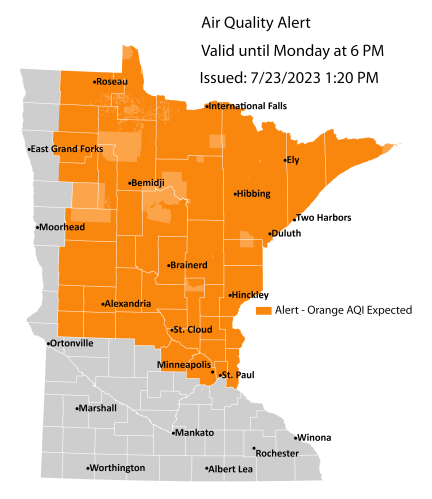
Air quality is expected to reach the orange AQI category in central and northern Minn., which is unhealthy for sensitive groups.
The Minnesota Pollution Control Agency (MPCA) has expanded the current air quality alert for central and northern Minn. to include the northern half of the Twin Cities metro. The expanded alert area in the Twin Cities metro is effective until 6 a.m. on Monday, July 24. The original alert area remains in effect until 6 p.m. on Monday. The affected areas include the Twin Cities, Brainerd, Alexandria, Hinckley, St. Cloud, Bemidji, International Falls, Two Harbors, Hibbing, Ely, Duluth, Roseau, and the tribal nations of Mille Lacs, Leech Lake, Red Lake, Grand Portage, and Fond du Lac.
Heavy ground-level smoke from wildfires in northern Alberta and British Columbia will impact northern and central Minn. on Sunday. Light northerly winds have brought this smoke into the northern half of the Twin Cities metro. Fine particle levels will reach the orange (unhealthy for sensitive groups) category across northern and central Minn., including the northern half of the Twin Cities metro on Sunday. Air quality across the southern Twin Cities metro and southern Minn. will be in the yellow (moderate) category. Winds will become southerly during the overnight hours on Monday and the smoke will begin to retreat north. Air quality should improve below the Orange category across the Twin Cities by Monday morning. Across central Minnesota and north central Minn., air quality is expected to improve below the orange category by Monday evening. Smoke will linger the longest across northeast Minn., and air quality is expected to remain in the orange category across northeast Minn. until the end of the day Monday.
Fine particle levels are expected to reach the orange air quality index (AQI) category, a level considered unhealthy for sensitive groups. In the orange area, sensitive groups should limit prolonged or heavy exertion and time spent outdoors.